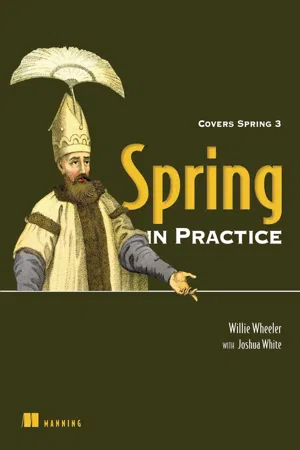
- 560 pages
- English
- ePUB (mobile friendly)
- Available on iOS & Android
Spring in Practice
About this book
Summary Spring in Practice shows you how to tackle the challenges you face when you build Spring-based applications. The book empowers software developers to solve concrete business problems by mapping application-level issues to Spring-centric solutions. It diverges from other cookbooks because it presents the background you need to understand the domain in which a solution applies before it offers the specific steps to solve the problem. About this Book Spring in Practice covers 66 Spring development techniques and the practical issues you will encounter when using them. The book starts with three carefully crafted introductory chapters to get you up to speed on the fundamentals. And then, the core of the book takes you step-by-step through the important, practical techniques you will use no matter what type of application you're building. You'll hone your Spring skills with examples on user accounts, security, NoSQL data stores, and application integration. Along the way, you'll explore Spring-based approaches to domain-specific challenges like CRM, configuration management, and site reliability. What's Inside
- Covers Spring 3
- Successful outcomes with integration testing
- Dozens of web app techniques using Spring MVC
- Practical examples and real-world context
- How to work effectively with data
Each technique highlights something new or interesting about Spring and focuses on that concept in detail. This book assumes you have a good foundation in Java and Java EE. Prior exposure to Spring Framework is helpful but not required.Purchase of the print book includes a free eBook in PDF, Kindle, and ePub formats from Manning Publications. About the Authors Willie Wheeler is a Principal Applications Engineer with 16 years of experience in Java/Java EE and Spring Framework. Joshua White is a Solutions Architect in the financial and health services industries. He has worked with Spring Framework since its inception in 2002. Table of Contents
- Introducing Spring: the dependency injection container
- Data persistence, ORM, and transactions
- Building web applications with Spring Web MVC
- Basic web forms
- Enhancing Spring MVC applications with Web Flow
- Authenticating users
- Authorizing user requests
- Communicating with users and customers
- Creating a rich-text comment engine
- Integration testing
- Building a configuration management database
- Building an article-delivery engine
- Enterprise integration
- Creating a Spring-based "site-up" framework
Frequently asked questions
- Essential is ideal for learners and professionals who enjoy exploring a wide range of subjects. Access the Essential Library with 800,000+ trusted titles and best-sellers across business, personal growth, and the humanities. Includes unlimited reading time and Standard Read Aloud voice.
- Complete: Perfect for advanced learners and researchers needing full, unrestricted access. Unlock 1.4M+ books across hundreds of subjects, including academic and specialized titles. The Complete Plan also includes advanced features like Premium Read Aloud and Research Assistant.
Please note we cannot support devices running on iOS 13 and Android 7 or earlier. Learn more about using the app.
Information
Chapter 1. Introducing Spring: the dependency injection container
- Major functional areas of the Spring Framework
- Flexible configuration using dependency injection
- Wiring beans using XML
- Autowiring and component scanning using annotations
1.1. What is Spring, and why use it?
Figure 1.1. A high-level block diagram illustrating Spring’s six basic functional areas

1.1.1. The major pieces of the framework
The Core Spring Container
Aspect-oriented programming (AOP)
Data Access/Integration
Web
Test
1.1.2. Why use it?
- Quality— From the overall design of the modules, packages, class structures, and APIs to the implementation and test coverage of the source code, the Spring Framework is a great example of high-quality open source software.
- Modularity— As we mentioned earlier, the framework has evolved into roughly 20 modules, giving developers the freedom to choose which parts of the framework to use in their applications without the need to include the entire framework.
- Promotes best practices— Spring’s plain old Java object (POJO)-based programming model promotes decoupled component models, unit testing, and other best practices.
- Modest learning curve— Due to the consistency and simplicity of the APIs, Spring isn’t hard to learn. As we make our way through the framework, you’ll see that common patterns emerge. Plus, hundreds of resources online and in print are at your disposal, including message boards where the core developers often participate.
- Popularity— As evidenced by myriad publications, websites, and job postings, the Spring Framework is almost ubiquitous.
Table of contents
- Copyright
- Brief Table of Contents
- Table of Contents
- Preface
- Acknowledgments
- About Spring
- About this Book
- About the Cover Illustration
- Chapter 1. Introducing Spring: the dependency injection container
- Chapter 2. Data persistence, ORM, and transactions
- Chapter 3. Building web applications with Spring Web MVC
- Chapter 4. Basic web forms
- Chapter 5. Enhancing Spring MVC applications with Web Flow
- Chapter 6. Authenticating users
- Chapter 7. Authorizing user requests
- Chapter 8. Communicating with users and customers
- Chapter 9. Creating a rich-text comment engine
- Chapter 10. Integration testing
- Chapter 11. Building a configuration management database
- Chapter 12. Building an article-delivery engine
- Chapter 13. Enterprise integration
- Chapter 14. Creating a Spring-based “site-up” framework
- Appendix. Working with the sample code
- Index
- List of Figures
- List of Tables
- List of Listings